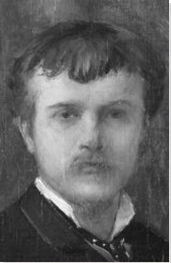Summary of Jules Bastien-Lepage
In spite of a career that spanned no more than a decade, Jules Bastien-Lepage - or the "painter of peasants" as he was sometime known - can be credited with expanding the vocabulary of French modernism beyond the light tones and touch of the Impressionists. He built a bridge between the Barbizon School and French academy painting while still allowing for the influence of the "new painters" to inform his style. Known primarily for two genres, the rural landscape and portraiture, he captivated the Salon with the honesty of his canvases and built up a group of devoted followers throughout France and across Europe. Without consciously doing so, Bastien-Lepage created a body of highly personal work that saw him fix his place in the timeline of the Naturalism movement.
Accomplishments
- Bastien-Lepage made no concessions to romanticism in his art having felt a personal duty to remain "true to nature" and to the Meuse region in which he grew up. Such was his attention to detail, his rural landscapes carried an almost photographic quality. It was an approach that helped defined an alternative modern approach to plein air painting such as that practiced by the likes of Camille Pissarro and Alfred Sisley.
- In defiance of the Salon artists who traveled to the provinces to create sentimental views of rural living, Bastien-Lepage painted that milieu as someone who understood the heritage of the terrain and its people. His landscapes were populated with honest workers and peasants who his brush rendered with authenticity and dignity.
- Many historians have drawn direct comparisons between Bastien-Lepage and the co-founder of the Barbizon School, Jean-François Millet. Both artists celebrated the honest toil of peasant labor. But whereas Millet imbued his subjects with a biblical reverence, Bastien-Lepage's peasant paintings "spoke for themselves" in the sense that his land workers were represented without the adornment of a moral sub-text.
- Bastien-Lepage complimented his rural scenes with a series beautifully-executed portraits. He was much in demand as a portraitist and his reputation spread throughout Europe. With fluid handling of brush and palette, his portraits showed a rare empathy between artist and sitter while his subjects were drawn from all groups in society including nobility, political figures, performing artists and the working classes.
- Though sometimes forgotten, Bastien-Lepage was an academy trained painter. In his early career he produced some magnificently staged religious parables. But his greatest legacy to his Academy training came later in his career when he overturned the conventions of History Painting by representing France's greatest war heroine, Joan of Arc, as a peasant girl in a contemporary naturalistic setting. The painting was not to every critic's liking but it was hugely popular with the public and remains arguably his most well-known painting.
The Life of Jules Bastien-Lepage
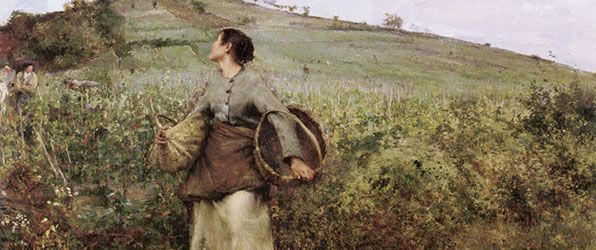
"Instead of holding as absolute truths the theories and conventions of the school and the studio", Bastien-Lepage implored his fellow painters, "we need to renew the education of our eye, by looking with sincerity upon things as they are in nature".
Important Art by Jules Bastien-Lepage
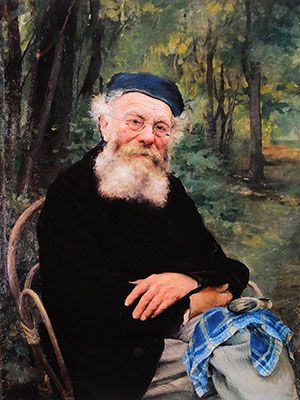
Son grand-père (Portrait of My Grandfather)
Bastien-Lepage's beloved grandfather is the focus of this painting. The old man is depicted in a garden, seated in a cane chair, with arms crossed in his lap and a stare that seems to engage the viewer. In describing this painting, author André Theuriet stated: "His striking face stood out well detached from the background of trees; the black velvet cap sloping jauntily towards his ear give effect to the shrewd Socratic face; his blue eyes twinkled with humour; the nose was broad [;] the white forked beard spread itself over an ancient vest of the colour of dead leaves; the hands, painted like life, were crossed upon the grey trousers".
This was an important early painting in Bastien-Lepage's career. As well as providing evidence of his love for his family and the countryside of Damvillers, it introduced what would be the two dominant threads in his oeuvre: nature and portraiture. The charmingly tender portrait had the effect of bringing him an early taste of public recognition when it debuted at the Paris Salon in 1874. Speaking of the significance of this event, Theuriet describes how, "before this picture, so true, so frank [...] the public stood delighted, and the name of Bastien-Lepage, unknown before, figured the next day in the first place in the articles on the Salon".
Oil on canvas - Collection of Musée d'Orsay
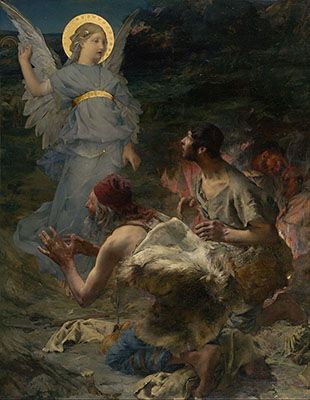
The Annunciation to the Shepherds
According to author Fr. Crastre, "Bastien-Lepage was no studio painter; it was not from the height of a window that he chose to contemplate nature, but in the open fields, in the very heart of the furrows; and it was there also in the midst of the wheat and the rye, that he set up his easel and painted his peasants in action in the daily fulfilment of their thankless task". But it is easy to overlook that Bastien-Lepage was a classically trained painter (as The Annunciation to the Shepherds amply demonstrates).
As a student of the Académie des Beaux-Arts, he was one of ten finalists in the 1875 Prix de Rome competition. The Académie selected the biblical theme and, as the painter and writer Cathy Locke describes, the "Finalists were required to enter into the loge for ninety days to paint their interpretation of the given theme. This ordeal entailed confining the aspirants into small rooms separated by partitions working under the supervision of guards, with each entrant permitted to depart only during evening hours". On completion of the paintings, the works were put on public display and the general consensus was that Bastien-Lepage's canvas would easily win him the prestigious award. The Prix de Rome went, however, to Léon Commere. The jury had objected to Bastien-Lepage's entry because he chose to render the Annunciation at twilight when, according to historical accuracy, the Annunciation was a night scene.
Locke speculates that the artist might have fallen under the influence of the Impressionists in that "Bastien-Lepage felt that the quality of light at twilight was more aesthetically pleasing than the limited amount of light available to him in a night scene". Though he did not win the grand prize, Annunciation to the Shepherds revealed his technical virtuosity for all to see.
National Gallery of Victoria, Melbourne
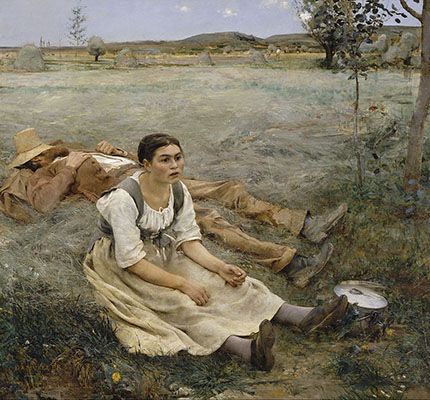
Les Foins (Haymakers)
In the painting, Bastien-Lepage depicts two peasants taking leave from the heavy toil of working the land. In the foreground a weary young woman is seated, arms resting on her outstretched legs; her shoulders slumped. The artist described her thus: "my young peasant is sitting with her arms apart, her face hot and red; her fixed eyes seeing nothing; her attitude altogether broken and weary. I think she will give the true idea of a peasant woman". Her companion is lying on his back, hands on his chest and his straw hat covering his face. In the background can be seen stacks of hay, effectively confirming the pair's status as manual farm workers.
Bastien-Lepage makes no effort to romanticize or dramatize his scene. He said of the painting: "I have had hard work to set up my first ideas, being determined to keep simply to the true aspect of a bit of nature. Nothing of the usual willow arrangement, with its branches drooping over the heads of the people to frame the scene. Nothing of that sort". The famous Realist novelist, Émile Zola, described the painting in fact as "the masterpiece of naturalism in painting" and honored Bastien-Lepage by calling him the, "grandson of [Jean-François] Millet and [Gustave] Courbet". The Musée d'Orsay went further, calling the composition "daringly photographic" in the way that "the horizon is unusually high, allowing the hay 'like a very pale yellow cloth shot with silver' to fill the main part of the canvas". The d'Orsay adds that "the light palette, and close framing of the figures are signs of modernity within the naturalist approach".
Oil on canvas - Collection of Musée d'Orsay, Paris, France
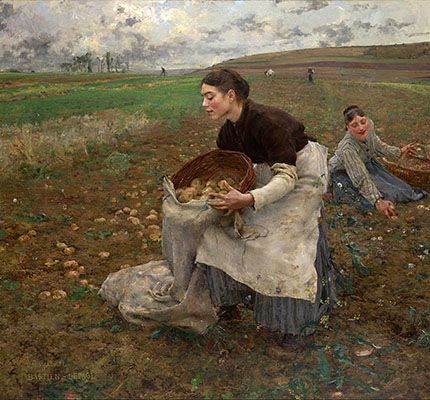
Potato Gathers (The Season of October)
This painting, considered by some to be his greatest masterpiece, was a companion piece to Haymakers. Named after the month of harvest time, two peasants are depicted working the fields. In the foreground a young woman is bent over trying to transfer the basket of potatoes she has collected into a large canvas sack while the woman positioned behind her continues the hard work of the harvester. The landscape seems to stretch on and on before meeting the horizon line under a gray, cloud-filled sky. According to the National Gallery of Victoria's website, "Bastien-Lepage had planned to paint rural life as he knew it, celebrating its hardships as well as the inherent dignity of the peasants themselves [and he] particularly despised those city painters whose sentimental views of rustic life confirmed their ignorance of it, but whose works continued to fill the annual Salons".
Like Haymakers, Potato Gatherers lacks the social realism of works by Courbet and Millet (artists to whom Bastien-Lepage was routinely compared). As author Fr. Crastre states, "unlike Millet [in his 1857 painting The Gleaners] Bastien-Lepage does not awaken in us any compassion for these beings who toil, stooping above the earth; no touch of bitterness saddens his pictures, and the types which he shows to us have the healthy vigour of peasants who live their lives in the open air and love the soil which nourishes them". The painter and writer Cathy Locke suggests that the "peasants [...] are suspended in time as if in a snapshot [and that the] awkward gesture of the peasant in the foreground compared to her relaxed and smiling companion seem incongruous to the vigorous task at hand". She adds that the artist "merges the color and texture we would see in a landscape by Camille Pissarro or Alfred Sisley with the realism of French academic figurative art of the day. In this way we see his relationship to Impressionism combined with the influence of academic study".
Oil on canvas - Collection of National Gallery of Victoria, Melbourne, Australia
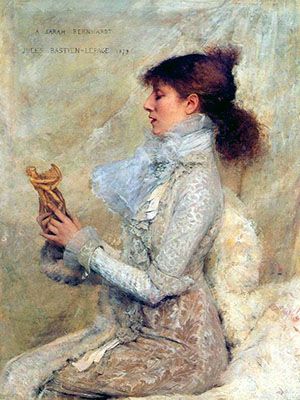
Portrait of Sarah Bernhardt
In this work Bastien-Lepage renders a portrait of the legendary nineteenth century French actress Sarah Bernhardt as she admires a statute of Orpheus, the mythical Greek legend of music and poetry. In describing the work, author Fr. Crastre refers to this "magnificent portrait [as] a marvel of expression and of delicate art, embodied in a pale symphony of tenderest whites, blending harmoniously with the warmest tones of gold". Crastre adds that Bastien-Lepage treats Bernhardt's "expressive and intellectual features [...] with a vigour which does full justice to the classic beauty and virile energy of the sitter".
While his legacy is (rightly) anchored in his pivotal role within the development of Naturalism, Bastien-Lepage was able to separate himself from these pursuits to render domestic portraits. This painting in particular helped spread his reputation as a superb portraitist across Europe and demonstrated the humility with which he imbued his sitters. There is an inherent drama to both the pose of the sitter and her gaze which echoes and anticipates the intensity with which she performed her roles in many of the great plays of the late nineteenth and early twentieth centuries. It also shows off the artist's exemplary handling of color and his skill at capturing something of the mystique of his sitters. Crastre supplied a quote from a critic for the Revue des Beaux-Arts which read, "The artist's hand was sure of itself; it neither groped nor hesitated. The execution is such that the drawing of the gown and the lines of the face seem to have been traced by an engraver's tool".
Oil on canvas - Collection of Legion of Honor Museum, San Francisco, California
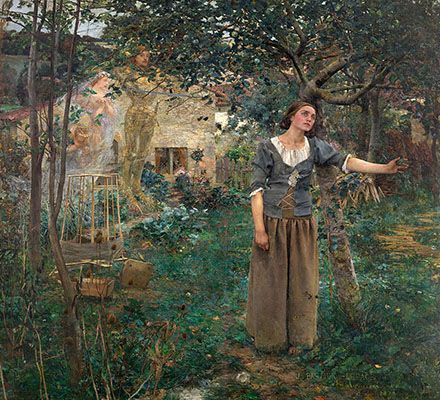
Jeanne d'Arc (Joan of Arc)
Although set within his familiar home surroundings, this piece, one of the artist's most famous, was a rare excursion into patriotic History Painting. The painting is that of the French teenage martyr, Joan of Arc, who is here depicted standing in the foreground of the canvas. The overturned stool and abandoned loom suggest she has been suddenly interrupted in her work. She gazes up, trance-like, through piercing blue eyes as her left arm stretches out in front of her. The natural surroundings in which she stands are rendered in such exacting detail that the painting has an almost photographic quality. This naturalistic narrative is interrupted, however, by the three ethereal-like figures behind her which are rendered with much less attention to detail.
Bastien-Lepage approached this subject in a modern way; choosing to depict France's greatest heroine, not at as the war hero (clad in her iconic silver armor) leading the French in the Hundred Years War but rather at the moment, aged just thirteen, when she heard the voice of God and the three saints Catherine, Margaret, and Michael appear before her and urge her to take up the fight against the English. Theuriet praised the modern treatment stating, "never had Bastien-Lepage created a figure more poetically true than this Lorraine shepherdess, so pure, so human, so profoundly absorbed in her heroic ecstasy".
One of the reasons this painting enjoyed such popularity when it debuted was due to political events. According to author Christopher P. Jones, "the figure of Joan of Arc had enjoyed renewed interest in France [in 1879] since the country had recently been defeated in the Franco-Prussian war and had part of its land annexed by Germany - none other than the province of Lorraine [the province from where Joan of Arc hailed]. The invocation of national heroes became especially important at the time, and Bastien-Lepage's painting can be seen as a fulfilment of that need". According to Locke, critics at the Salon of 1880 "praised Bastien-Lepage's use of pose and facial expression to convey Joan's spiritual awakening but found the inclusion of the saints at odds with his naturalistic style [and that] in comparison to his previous works honored at the Salon, Joan of Arc creates a very closed-in feeling, suffocating the figure. She adds that "the painting was compared to English Pre-Raphaelite for its profusion of botanical detail [and it evocation of] Victorian sentimentality".
Oil on canvas - Collection of Metropolitan Museum of Art
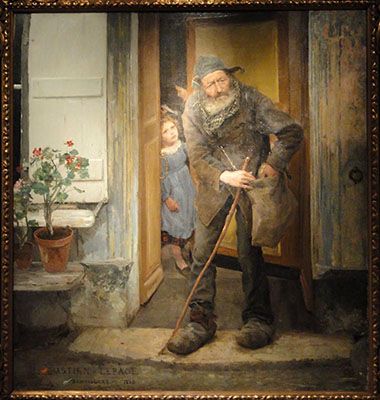
The Beggar
Aptly titled, an old beggar man is the subject of Jules Bastien-Lepage's painting. Depicted in dirty clothes and a long unkempt beard, he holds a stick in one hand while in the other he is placing something in his bag; most likely the scrap of food which someone in the house has just given him. The door is in the process of being closed behind him but has been blocked by a young girl in a bright blue dress who watches him intently as he prepares to leave.
Author George Clausen states that in Bastien-Lepage's beggar, "we find a most perfect realization of character: the whole life-history of the man seen and brought before us". The viewer is directly confronted with the reality of the scene; the man's abject poverty in stark contrast to the innocence and refinement of the little girl standing behind him. This dichotomy is echoed in the bright blooms of the flowers in the potted plant resting on a ledge next to the door; so full of life when compared to the old man in his dour colors and withered physical state. As the door is closing, viewers are visually reminded that these two people and by extension the two societal groups of which they are a part will always remain separate.
Oil on canvas - Collection of Ny Carlsberg Glyptotek, Copenhagen, Denmark
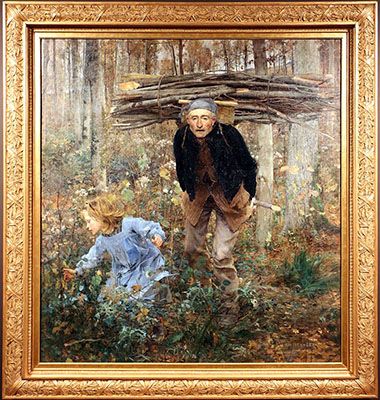
Le Père Jacques (The Wood Gatherer)
The Wood Gatherer, painted for the Salon of 1882, is one of Jules Bastien-Lepage's most important works. An old man dominates the center of Bastien-Lepage's frame. Stooped over, he carries on his back a large bundle of heavy sticks and branches which he has gathered during his walk in the woods. In front of him, in the left foreground, his companion, a young girl wearing a blue dress, picks flowers with her right hand while holding a small bunch of daisies in her left. Bastien-Lepage's works were so realistically rendered that it is easy to view them solely as exemplars of the Naturalist movement. But this work also carries a simple commentary on generational relations. In this example, according to Locke, "The old woodsman, a family friend, and his granddaughter represent the heavy weariness of old age and the innocence of youth, as well as the passage of time".
Some Salon critics took issue with Bastien-Lepage's paintings. For them, his refusal to embellish his work with chiaroscuro or to stage scenes in order that his subjects might be represented in a more appealing light, was a limitation. This criticism had no impact on Bastien-Lepage who continued painting his subjects exactly as they appeared to his eye. He stated, "my Wood-cutter in the last Salon was reproached with want of air [....] There is a great deal of routine and prejudice in that criticism of the perspective of my pictures done in the open air. It is the criticism of people who have never looked at a landscape, except crouching down or sitting. When you sit down to paint, you naturally see things quite differently from the way you see them standing [...] We need to renew the education of our eye, by looking with sincerity upon things as they are in nature, instead of holding as absolute truths the theories and conventions of the school and the studio". This wilful attitude stood him in good stead. As Locke notes, "By the early 1880s, Bastien-Lepage had become the leader of the Naturalist school, and many of his contemporaries believed that he would one day succeed Manet as the leader of modern painting".
Oil on canvas - Collection of Milwaukee Art Museum, Milwaukee, Wisconsin
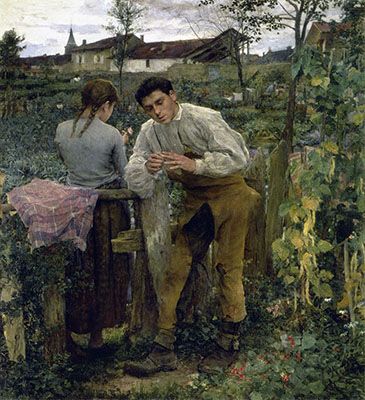
L'Amour au Village (Village Love)
Here Bastien-Lepage has beautifully captured the innocence and sweetness of young love in this depiction of a conversation between two peasant youths in the French countryside. Describing this painting, Crastre states, "he depicted with charming naturalness the uncomplicated and naïve courtship of rustic lovers. Here are a pair who are untroubled by curious glances; the nearer houses of the village are quite close by. Bending slightly towards his sweetheart, the man is murmuring his avowals in her ear [...] Strapping fellow that he is, he evidently lacks the habit of making pretty speeches; we can see that from the embarrassed air with which he twists his fingers. His words, however, are plainly not lacking in eloquence, for the girl [...] has bent her head and, although her back is turned, we are sure that she is blushing as she listens to his declaration".
More than a simple statement on love; this work shows how beautifully Bastien-Lepage was able to capture on his canvases the lives of the French peasantry. According to Crastre once more, "the artist's watchful eye has succeeded in discovering, in the life of the peasantry, that state of mind, which is common to them all, that immutable gesture which have always made and always will make. He has understood and translated with inspired eloquence their rugged strength, their naïve awkwardness, their simple intelligence". Bastien-Lepage's friend and fellow artist Marie Bashkirtseff said on seeing the painting "he's not just a painter, but a poet, a psychologist". Indeed, this work was of great appeal in Russia; a fact that was supported by the country's commissioning it as a postage stamp in 1973. According to the website of the Pushkin State Museum of Fine Arts, this painting was "particularly popular among Russian artists of the late nineteenth and early twentieth century [and was] much admired by Valentin Serov, Mikhail Nesterov and [...] Leo Tolstoy".
Oil on canvas - Collection of Pushkin State Museum of Fine Arts, Moscow, Russia
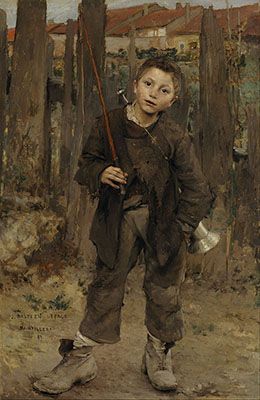
Pas Mèche (Nothing Doing)
A young peasant boy is the subject of Bastien-Lepage's Nothing Doing. While captured in a moment of idleness; his appearance reinforces the fact that his life is a difficult one. The website of the Scottish National Gallery describes the painting thus: "a young boy looks directly out of the painting clad in raggedy clothes and large unlaced boots. His relaxed air fits the title which is an abbreviation of the French slang: 'Il n'ya pas meche' meaning 'There's nothing doing.' The whip he holds and the horn slung on his back suggest that he was a barge boy who would have controlled the horses pulling the barge and alerted the lockmasters of its imminent arrival".
Paintings such as this influenced the next generation of realist painters. According to author William S. Feldman, "the series of immensely popular genre themes that Bastien-Lepage produced until his untimely death in December 1884 earned him an influence comparable to Manet, some sixteen years his senior". Included amongst his followers, who were eager to emulate his unvarnished view of nature, were a group of young artists known as The Glasgow Boys, who focused their work on scenes of rural Scotland.
Oil on canvas - Collection of Scottish National Galleries, Edinburgh, Scotland
Biography of Jules Bastien-Lepage
Childhood and Education
Jules Bastien-Lepage was raised in a close family unit that included both parents, his beloved grandfather, and a younger brother (Émile, who would also become a professional artist). His parents owned a modest farm in the idyllic village of Damvillers in Northern France, close to the France/Belgium border. This setting proved to be the key influence on his paintings of rural life.
Bastien-Lepage's father was a keen amateur artist, and nurtured his sons' aptitude for drawing. According to his biographer André Theuriet, his father "required that Jules should draw with pencil on paper the various articles in use upon the table - the lamp, the jug, the inkstand, etc. It was to this first education of the eye and of the hand that Bastien-Lepage owed that love of sincerity, that patient seeking for exactness of detail, which were the ruling motives of his life as an artist". That being said, his father was not comfortable with the idea of his son's interest developing beyond a hobby and was unhappy when he declared his desire to pursue art as a profession. To fulfil his father's wishes, and with a great strain being put on the family resources, Bastien-Lepage attended the College of Verdun from the age of eleven. It was hoped that the young Jules would harness his sublime drawing ability and pursue a career as a draftsman. However, Bastien-Lepage showed little aptitude for draftsmanship and preferred to fill his drawing pads with scenes of rural life.
Early Training
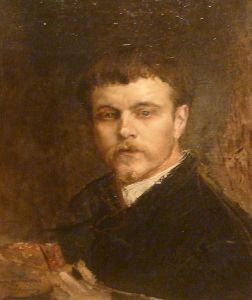
Aged 19, his college education complete, Bastien-Lepage expressed his desire to travel to Paris to study art. His ambition was beyond the financial reach of the family and, on the advice of a family friend, he took up a job with the Central Postal Administration. Though he earned barely enough to live on, the post meant he was able to attend art classes at the École des Beaux Arts where he registered under his given name, Jules Bastien (he soon added Lepage, his mother's maiden name, as a way of sounding more distinctive). For six months he balanced both roles. He worked at the post office from 3:00 to 7:00 am in the sorting office, before delivering mail till noon. He attended school in the afternoons and, with the added burden of homework, his double life became impossible to maintain. After six months Bastien-Lepage resigned his post at the Post Office and entered art school as a full-time student.
Armed with a letter of recommendation from the academic painter William Bouguereau, Bastien-Lepage approached Alexandre Cabanel who took him under his wing and schooled him in the traditions of academy painting. Realizing his potential, Bastien-Lepage's supported their son as best they could. His mother sent him a small sum of money every month and this, with an allowance of 600 francs from the Council General of Meuse, covered his bed-and-board. Bastien-Lepage's threw himself into his studies, but his ambition was interrupted with the outbreak of the Franco-Prussian War in 1870 when he enlisted in a company of volunteers. According to Theuriet, "One day in the trenches a shell burst near him and sent a clod of hardened earth straight at his chest. He was taken to the ambulance, where he remained during the last month of the siege, while another shell fell upon his studio, and there destroyed his first composition, a nude nymph with her arms clasped over her blonde head, and bathing her feet in the waters of a spring". He would spend the majority of 1871 recuperating in Damvillers before returning to Paris in 1872.
Mature Period
Bastien-Lepage had first submitted work to the Paris Salon in 1870. In these early works he copied the landscapes of Jean-Antoine Watteau and inserted fashionable young women into the scenery. These pieces went largely unnoticed but in 1874 he painted his grandfather in the family garden. It proved to be a turning point in his career. His grandfather, with his proud beard and black velvet beret, was illuminated against a rich green backdrop of trees. The painting perfectly captured humble country life, and it delighted the Parisian public. It won him a third-place medal and the name Bastien-Lepage started to feature in Salon literature and reviews.
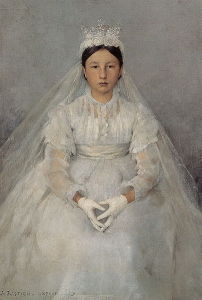
The following year, Bastien-Lepage entered The Communicant, and a portrait of the politician and industrialist Simon Hayem, to the Paris Salon. The Communicant in particular showed the artist's ability at revealing his subject with a frank realism that touched the public in a way that academic art could not. According to Theuriet, "this young girl's simple awkward bearing, as she stands out from a creamy background, with all the stiffness of her starched white veil, naively opening her pure hazel eyes, and crossing her fingers, ill at ease in the white gloves, is a marvel of truthful painting [...] It is interesting, as being the first of those small, lifelike, characteristic portraits, in a style at once broad and conscientious, which may be reckoned among the most perfect of this painter's works".
Like other exceptional students at the time, Bastien-Lepage was entered into the prestigious Prix de Rome competition. Having been tipped to win, he took his first defeat in 1875 to heart, but having failed to win on a second occasion (in 1876), he realized that he had no real interest in travelling to Italy to study and had only entered the competition because that was the path elite academy students were expected to follow. Indeed, Bastien-Lepage began to question the true value of academic training and vowed to produce a more personal body of work. He said later, "I learned my business in Paris, I shall not forget that; but my art I did not learn there. I should be sorry to undervalue the high qualities and the devotion of the masters who direct the school. But is it my fault if I have found in their studio the only doubts that have tormented me? When I came to Paris I knew nothing at all, but I had never dreamed of that heap of formulas they pervert one with. In the school I have drawn gods and goddesses, Greeks and Romans, that I knew nothing about, that I did not understand, and even laughed at. I used to say to myself that this might be high art; I wonder sometimes now if anything has resulted from this education".
Bastien-Lepage's preference for the sombre tones of Naturalism clearly distinguished him from the light and colorful Impressionists who were gaining popularity in France at the time. Indeed, historian William S. Feldman stated that Bastien-Lepage saw himself "as heir to the Realist tradition of Millet and Courbet" and espoused the philosophy that "'Nothing is good but truth [and] I come from a village in Lorraine [and] mean, first of all, to paint the peasants and landscapes of my home exactly as they are'". While he kept an apartment and studio in Paris, Feldman observed that the artist remained "True to his credo [and] conceived a continuing series of monumental plein air compositions focused in this direction, and executed in a highly personal, eclectic style". Even when he took on bigger subjects, such as his painting of French martyr Joan of Arc, he placed her in the Damvillers countryside and used a local teenager as his model. Historical figures aside, he conceived of a series of large plein air paintings that evoked his own upbringing and saw him produce what were arguably his most important works, Haymakers (1877) and Potato Gatherers (1878).
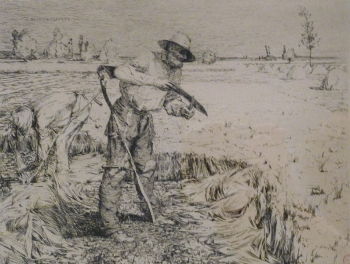
Both paintings were exhibited at the Paris Salon in 1879 where they attracted attention for their candid realism. Identical in size and shape, and featuring the same model, Bastien-Lepage's cousin, Marie-Adéle Robert, it was Potato Gatherers that drew direct comparisons with Millet, and especially his 1857 painting, The Gleaners. Both Potato Gatherers and The Gleaners celebrated the beauty of the land, and both exalted the virtues of manual labor, but Bastien-Lepage's painting was considered much less sentimental in tone. Both Haymakers and Potato Gatherers were a success but it was the latter that became the key attraction, winning over both the public and the Salon jury.
As the painter and writer Cathy Locke observed, along with Haymakers and Potato Gatherers, Bastien-Lepage also exhibited a portrait of the rising French actress Sarah Bernhardt. "Painted in high key values", Locke noted that "this small gem of a portrait" was made when both Bernhardt and Bastien-Lepage were rising stars, and since both were "making the rounds with the social elite of Paris, it would have been only natural for [Bernhardt] to sit for this portrait". Locke adds that at the age of just thirty-one, Bastien-Lepage was awarded the prestigious Legion of Honor for the three Salon entries, and thereby confirmed the painter's "official arrival on the French art scene".
Bastien-Lepage's rising star brought him financial security. According to Theuriet, "he took his mother to a large shop and had silks for dresses spread out before her. 'Show some more,' cried he. 'I want Mama to choose the best'", and even though she was disinclined to wear such finery, "She was obliged to give way". He was also comfortable enough to purchase land adjacent to the family farm. As Theuriet explains, Bastien-Lepage, "employed his gains in adding to the paternal domains. [including the purchase of] an orchard situated in the old moat of the town, which had belonged to an unfrocked priest".
While peasant and nature scenes brought him success and personal satisfaction, Bastien-Lepage had also made his name as a painter of beautiful, and highly realistic, portraits. His reputation spread beyond France to the English nobility and he received the important commission to paint the portrait of the Prince of Wales which he rendered in 1879. According to Crastre, "to Bastien-Lepage portrait painting was only a side issue, a form of relaxation between two landscapes; his predilection, his one object in life, so to speak was to return constantly to his peasants, his scenes of toil, his fields of Lorraine". That his work appealed to the young artists of the day can be seen in the friendship he developed with the Russian Maria Bashkirtseff in 1882. His influence is evident in the way she rendered both her portraits and her street scenes. While they shared a love of art, they were also both fated to tragically short lives with Bashkirtseff dying of tuberculosis at the age of twenty-five, less than two months before Bastien-Lepage's own death.
Later Period
At the beginning of 1881, Bastien-Lepage made painting excursions to Switzerland and Italy. Sadly, serious illness would make these the Frenchman's last overseas tours. In 1883, Bastien-Lepage developed intense kidney pains and, as Crastre describes, "he became melancholy, nervous, irritable; he shut himself up in his studio [...] and even his best friends could not gain admittance". Eventually his doctor was able to convince him to travel to the coastal region of Brittany in the hope that it might aid his recovery. For a brief period the beautiful nature and sunshine helped him to forget his troubles and he was able to paint freely. Soon, however, his condition worsened and he was forced to return to Paris to receive treatment. Writing to a friend, he complained that his, "digestive tube is always kicking up a row".
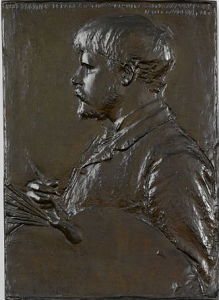
The Paris doctors informed the artist of the gravity of his situation and this time encouraged him to travel to Algeria believing that the North African climate might help his condition. He was in such poor health that he could not make the journey alone so his mother accompanied him in the capacity of his nurse. At first he seemed to be on the road to recover and, inspired by the new sights and sounds, he began painting in earnest. Focused only on his art he stated, "I am not afraid of death. Dying is nothing - the important thing is to survive oneself, and who can be sure of establishing a claim upon posterity? But there! I am talking nonsense! So long as our work is true, nothing else matters". Sadly, his health continued to deteriorate and, as Crastre put it, "before long the ravages of the disease began to make headway; the kidneys no longer performed their function, and he suffered atrocious agonies which stretched him for days at a time on his back. Even the burning heat of the African sun no longer had strength enough to animate his shattered physique; the brush, which the artist from time to time attempted to take up, fell from between his fingers".
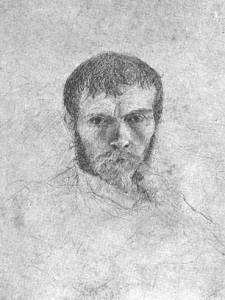
A seriously ill Bastien-Lepage returned to Paris in May of 1884. He still longed to paint and, as Crastre describes, "as long as he could hold a brush, Bastien-Lepage continued to work, in spite of the sufferings which racked him". He eventually grew so weak that he could barely hold a brush. He stated, "If I was told: They are going to cut off your two legs, but after that you will be able to paint again, I would willingly make the sacrifice". Having put up a brave fight, Bastien-Lepage succumbed to his illness six months after returning to Paris. He was aged just thirty-six. The Musée d'Orsay records on its website that "The day after Jules Bastien-Lepage died at his Paris studio on rue Legendre, on the 10th December 1884, the world press announced his premature death and burial in the family cemetery in Damvillers in the Meuse region of France. In just ten productive years, this son of a modest farming family had won an eminent place in the French and international art scene".
The Legacy of Jules Bastien-Lepage
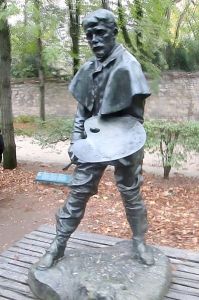
Although his career lasted no more than a decade, Bastien-Lepage made a profound impact on the French art world. Referred to as "the grandson of Millet and Courbet" by French novelist Émile Zola, he captured the beauty of the French peasantry and countryside by rendering his subjects with an authentic realism. Speaking of the impact of his work, author George Clausen acknowledged the artist's, "love of nature and resolute determination not to depart from the strict literal truth as he saw it", and in so doing, "he brought to us what was in some ways a new view of nature - one whose truth was at once admitted".
Bastien-Lepage offered a challenge to the prevailing Impressionist style though this was not a conscious move on the part of the artist. As author Fr. Crastre explains, "as painter of the open air, he became in a certain sense the founder of a school, without meaning to be; for his conception of the painter's art won over a whole group of young artists who united in hailing him as their master". Author William S. Feldman added, "for a younger generation of painters disenchanted with the excesses of both conservative and radical camps, the 'juste milieu' ['middle ground'] approach of Bastien-Lepage represented the viable alternative. Consequently, a school of Bastien-Lepage followers emerged virtually overnight, attracting practitioners from France, Great Britain, and throughout Europe".
He had (albeit inadvertently) suggested a new way for future generations and directly influenced artists such as James Guthrie, John Lavery, and William York Macgregor who, as members of The Glasgow Boys, followed Bastien-Lepage's lead in painting rural Scotland. His style was also influential on a group of Australian Impressionist artists who adapted his techniques to capture the beautiful nature of their country and included artists Charles Conder, Fred McCubbin, Tom Roberts, and Arthur Streeton. His influence can still be felt today in the work of contemporary artists such as John Felsing, Steve Kestrel, and Ron Kingswood all of whom work in the style of Naturalism.
Influences and Connections

-
![Gustave Courbet]() Gustave Courbet
Gustave Courbet -
![Édouard Manet]() Édouard Manet
Édouard Manet -
![Jean-François Millet]() Jean-François Millet
Jean-François Millet -
![Henri Rousseau]() Henri Rousseau
Henri Rousseau - Alexandre Cabanel
- André Theuriet
- Marie Bashkirtseff
- Leon Augustin Lhermitte
- Fred McCubbin
- Tom Roberts
- John Felsing
- André Theuriet
-
![Modernism and Modern Art]() Modernism and Modern Art
Modernism and Modern Art -
![Naturalism]() Naturalism
Naturalism -
![Realism]() Realism
Realism - The Glasgow Boys
- The Heidelberg School
Useful Resources on Jules Bastien-Lepage
- Bastien LepageOur PickBy Fr. Crastre
- Jules Bastien-Lepage and His Art. A MemoirOur PickBy Mathilde Blind, André Theuriet, George Clausen, and Walter Sickert
